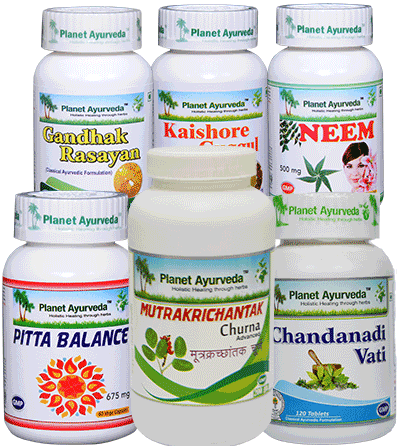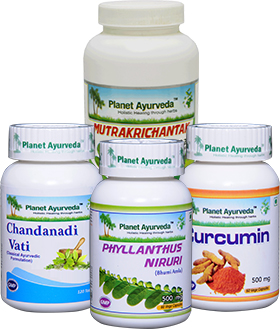Hunner Ulcers, Symptoms, Causes Diagnosis and Ayurvedic Treatment
Abstract
Since Hunner ulcers are seen only in people with intestinal cystitis, it’s important to know more about this painful life-altering bladder disorder before we can even understand how to deal with them. So in this article we will discuss in detail about introduction , ayurvedic correlation of disease, causes, symptoms of the disease, diagnosis and management of disease with modern as well as ayurvedic concepts.
Introduction
Hunner ulcers are painful ulcers in your urinary bladder. These ulcers are linked to another disorder called the painful bladder syndrome or interstitial cystitis. They occur in 10- 15% of people with interstitial cystitis .They appear as red patches on the bladder wall which can stiffen tissue and cause reduced bladder capacity. The ulcers in the bladder can be extremely painful. Hunner ulcers are formed on the walls of the bladder. As this disease has not been treated as it causes more discomfort to the patient.
Ayurvedic aspect of Hunner Disease
In the ancient era all the rogas(diseases) were managed by ayurvedic culture and the treatment was effective. In ayurveda Hunner disease can be correlated with vata and pitta predominance tridoshaj vyadhi. As pitta is more aggravated dosha in this disease ,there may be bleeding or pus discharge from the affected area. . For the treatment of hunner disease in ayurveda , we should treat the pitta dosha which is one of the tridoshas. .As there are adverse effects of allopathy and by ayurveda we can maintain the balance of doshas i.e pitta mainly to control the disease.

Causes of Hunner Ulcer
Hunner ulcer can be caused by many factors and symptoms may appear as disease inflates. Cause of hunner ulcer is not the one but many aggravating factors are there which cause the bladder wall to bleed or ooze pus discharge and painful condition worsen the situation.
Causes of hunner disease are listed below
- Bladder stone i.e any history of bladder stone can cause the bladder wall to ulcerate and bleed
- Any kind of infection which is not treated on time can cause the bladder wall to ulcerate and red patchy appearance
- Urinary bladder Cancer is the other reason that cause the ladder wall to form red patch and ulcerative appearance
- Kidney disease i.e any kind of kidney dysfunction causes the bladder to stiffen and reduce the bladder capacity.
- Multiple sclerosis
- Endometriosis
- STDs
Symptoms of Hunner ulcer
Due to the aggravating factors the symptoms appears in patient and cause uncomfort and pain to the patient. By seeing Symptoms it’s easy to make a diagnosis of that particular disease. And then thereby treat that disease. Some symptoms that appears in hunner ulcer patient are listed below-:
- Hematuria i.e Blood in urine appears
- Recurring bouts of pain in urinary bladder
- Pressure in pelvic area.
- Urgency i.e not able to control urine.
- Frequent urination.
- Pus discharge
Diagnosis of hunner ulcer
Patient came with above said symptoms and then for further evaluation certain investigations are to be done to rule out the disease .Diagnosis of hunner disease is mainly illustrated by blood test and urine test (for any kind of infection ) and cystoscopy (to view bladder wall)
- Medical history( bladder cancer or bladder cyst).
- Bladder diary ( it describes daily habits).
- Urine test ( for infection or blood in urine )
- Bladder scan (if urine is still in bladder after passing out)
- Cystoscopy
- Uroflowmetry
Treatment of Hunner’s ulcer
Hunner disease is curable and can be treated as soon as the diagnosis is made. Hunner ulcers can be cured by following ways
- Fulguration i.e by burning them off by bladder wall via laser or electricity .
- Resection of bladder wall i.e skin from around hunner ulcer is cut .
- Analgesics are given in order to relieve pain.
- Anti-anxiety drugs are to be given.
- Self care and behavioral medicines.
Lifestyle modification
Some lifestyle modifications are to be done in order to prevent and stabilize the disease and these methods help the patient to maintain stable health -:
- Use of caffeinated beverages- like tea , coffee, coals etc.
- Soda, artificial juice, fruit juices especially Cranberry juice can trigger intense pain and discomfort.
- Reduce stress.
Ayurvedic treatment of Hunner ulcer by planet ayurveda
Ayurveda is a science of life with a holistic approach to health and personalized medicine. Planet ayurveda is a company which is GMP certified and our products are supplied all over the world. Planet ayurveda makes herbal wellness a part of every home in the world. All the medicines are 100% safe as they are purely herbal with no side effects . Medicines are given according to the patient’s prakruti . Planet ayurveda gives the best quality and best results of the medicines and their results are very clear as they work with 100% efficiency.

The following herbal remedies from planet ayurveda are
- Chandanadi vati
- Kaishore guggul
- Gandhak rasayan
- Mutrakrichantak churna
- Pitta balance
- Neem capsule
Product description
1. Chandanadi vati
Ingredients of this vati are safed chandan (Santalum album), Amalkai (embillica offinale), Gokshura (tribulus terrestris) etc. Each tablet is 500mg of purified extract of drugs. Chandanadi vati balances pitta and kapha in the body. Chandanadi vati is used in nephritic syndrome, kidney failure, hunner ulcers, electrolyte imbalance to maintain healthy metabolism.
Dosage- 2 tablets twice a day.
2. Kaishore guggul
Ingredients of kaishore guggulu are – triphala (haritaki, vibhitaki, and amalaki), amrita (tinospora cordifolia), trikatu (Piper nigrum, piper longum, zingiber officinale) etc.This tablet helps to eliminate toxins from joints, in raised uric acid levels and gouty arthritis, blood purifiers.
Dosage -:2 tablets twice a day.
3. Gandhak rasayan
Ingredients of gandhak rasayan are shuddha gandhak (yellow sulfur) . Gandhak rasayan is used for skin problems, acts as antibacterial and antifungal. It is also used for itching and acts as a blood purifier. It helps to flush out toxins from the body through skin .
Dosage – 2 tablets twice a day after meals with water.
4. Mutrakrichantak churna
Ingredients of this churana are varun (crataeva nurvala), bhumi amla (phyllanthus niruri), gokshur (tribulus terrestris) etc. It supports a healthy urinary system and maintains healthy kidneys, and improves overall health, relieving urinary tract infections, kidney stones, high urea, high uric acid and creatinine levels.
Dosage-1 tsf twice a day with lukewarm water after a meal.
5. Pitta Balance
Ingredients of pitta balance are praval pishti( coral calcium), jwahar mohra pishti, kamdudha ras , akik pishti, giloy satva, mukta pishti etc. It helps to balance out pitta dosha in the body. And helps to get rid of diseases due to pitta .
Dosage -: 1 capsule twice a day after meal with plain water.
6. Neem capsule
Ingredients of neem capsule is neem (azadirachta indica) is a 500mg capsule. It is used in treatment of diabetes, antiulcer property, antifungal property , and also used in cancer patients and is best for blood purifiers and helps to get rid of skin related problems.
Dosage -: 1 capsule twice a day with plain water after a meal .
Contact my assistant to provide you the costing / ordering and delivery information at – costing.planetayurveda@gmail.com or call at +91-172-5214040 Or Check Website – www.PlanetAyurveda.com
Conclusion
It is better to take ayurvedic medicine because it has no side effects with best results over the years. Ayurved treats patients with ancient methods and effectively cures the patients. So the above-mentioned medicines of herbal ayurveda are best to treat the hunner ulcers because all the medicines are free from any preservatives and other chemicals that affect your health. All the herbs are purely vegetarian and made up of 100% naturally occurring organic herbs.




